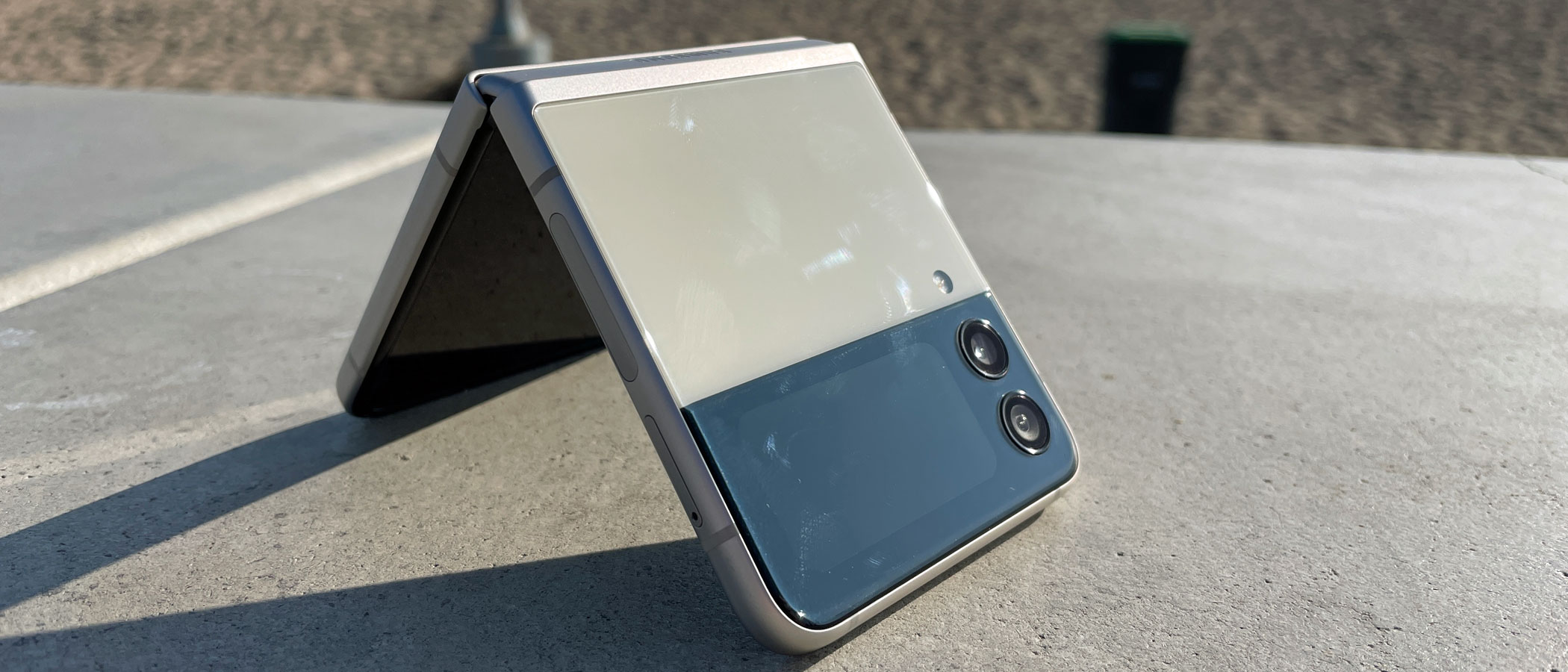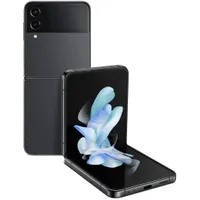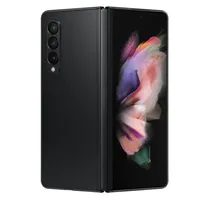TechRadar Verdict
The Samsung Galaxy Z Flip 3 is the best clamshell foldable you can buy, with specs and a price comparable with flagship phones. Its relatively small battery holds it back, as does its lack of a telephoto camera lens, and wary consumers may want to wait to see what innovations come in the Flip 4 – but if you want a phone that folds up to fit in more bags and pockets, while offering the same performance as flagship phones, the Z Flip 3 is a good option.
Pros
- +
Good lower price
- +
Good specs
- +
Refined design and displays
Cons
- -
No telephoto lens
- -
Middling battery
- -
Outer display still not terribly useful
Why you can trust TechRadar
The Samsung Galaxy Z Flip 3 is without a doubt the best clamshell foldable on the market, although it operates in what is an extremely limited device niche – only a few phones like the Z Flip and Motorola Razr have occupied the category already, and Motorola’s last contender is well out of date, with its successor stalling at launch.
The phone's main competition now will come from the new Samsung Galaxy Z Flip 4, which launched in August 2022 alongside the Samsung Galaxy Z Fold 4. So that's worth a look if you want the latest model.
But compared to its predecessor the Z Flip 3 further refines everything a clamshell foldable should be, as our Samsung Galaxy Z Flip 3 review will explain, and it also manages to be pretty good at everything else modern phones are supposed to do.
It kept up with other flagships around the time it launched, in terms of performance (Snapdragon 888 chipset, 8GB RAM, 128GB or 256GB storage) and when flipped open offers up a good-sized 6.7-inch plastic OLED display that delivers a picture somewhere between LCD and OLED levels of color vibrancy and crispness, and with a smooth 120Hz refresh rate.
The Z Flip 3’s relatively small 3,300mAh battery can be limiting (it rarely lasts more than a day), but the phone’s biggest shortcoming is its camera setup, which hasn't changed from its predecessors, the original Z Flip and its 5G variant (there’s no Z Flip 2, with Samsung skipping a number in order to keep its Flip range in line with its Z Fold series).
There are 12MP f/1.8 main and 12MP f/2.2 ultra-wide cameras on the rear, and a 10MP f/2.4 selfie camera. It’s an acceptable offering, but not comparable to what you’ll find on phones like the comparably-priced Samsung Galaxy S22 Plus with its 3x optical zoom, or phones with better telephoto cameras, like the S22 Ultra, which boasts a 10x optical zoom camera.
However, those other flagship phones can’t be folded up and slipped into a small pocket, and that’s a novelty that’s never been more affordable that it is here: with a starting price of $999 / £949 / AU$1,499, consumers can get a clamshell foldable for the price of a top-tier conventional flagship phone.
Sign up for breaking news, reviews, opinion, top tech deals, and more.
Not everyone needs that novelty, though, and it’s easy to see where the Z Flip 3 is a stepping-stone to a successor that’s even more affordable, packs zoom cameras, and has a large enough outer display to let you send texts or emails and use apps (Samsung has yet formally unveil the Z Flip 4 but it's launching on August 10).
As it stands, the phone is a joy to use for folks who are willing to pay for something more pocketable, and it's arguably one of the best foldable phones and best Samsung phones, but all its non-folding features can be had for much less elsewhere.
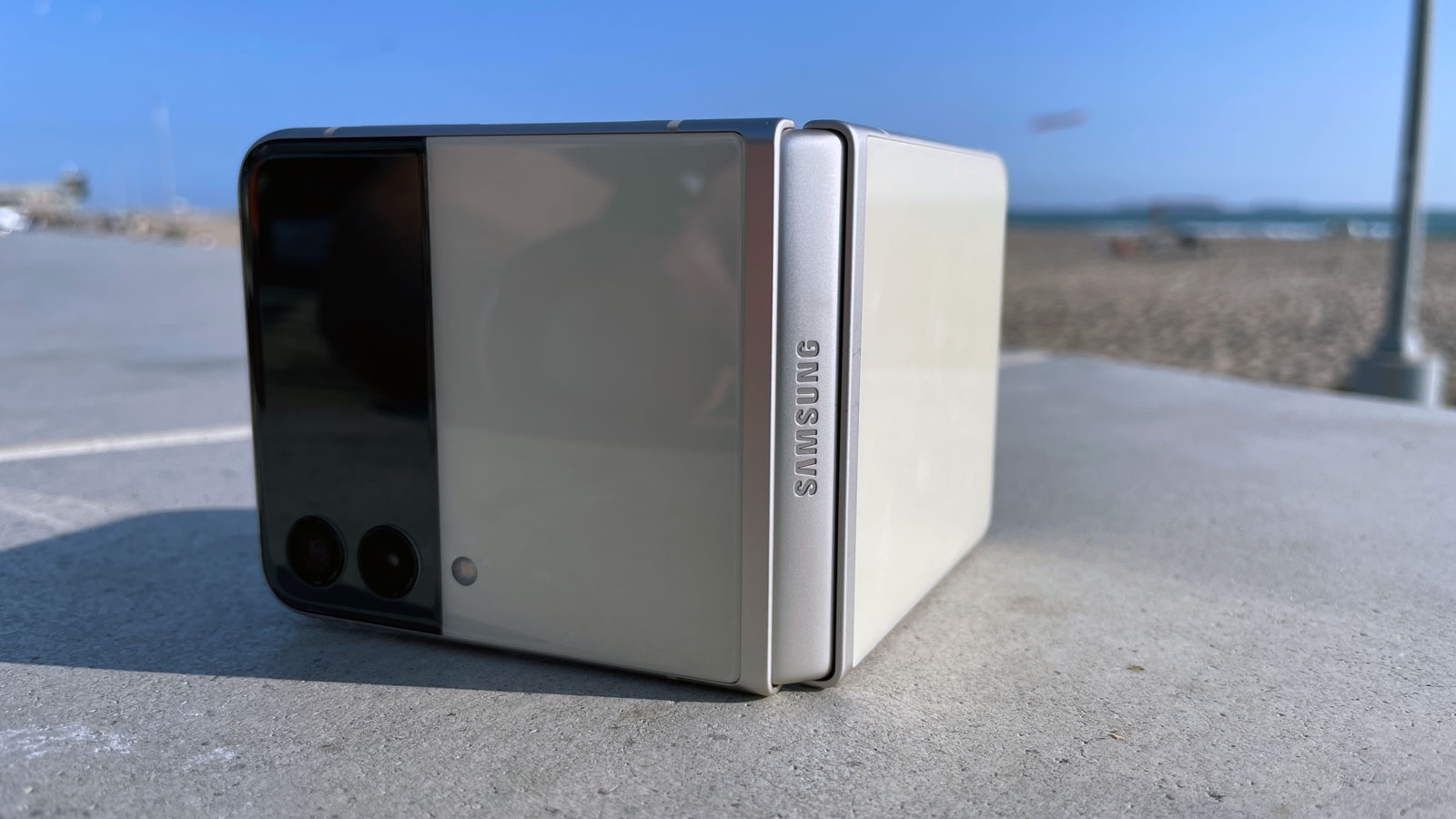
Samsung Galaxy Z Flip 3: price and release date
- Out now
- Starts at $999 / £949 / AU$1,499
Display: 6.7-inch, 1080 x 2640
Dimensions: 86.4 x 72.2 x 15.9-17.1mm folded / 166 x 72.2 x 6.9mm unfolded
Weight: 183g
Screen refresh: 120Hz
Screen brightness: 1200 nits
Water resistance: IPX8
Selfie camera: 10MP resolution
Main camera: 12MP resolution
Ultrawide: 12MP resolution
Battery: 3,300mAh
Memory: 8GB
Storage: 128GB or 256GB available
The Samsung Galaxy Z Flip 3 was officially unveiled at Samsung Unpacked on August 11, 2021 and went on sale on August 27 of the same year, in the US and UK. Those in Australia had to wait until September 10, 2021.
It comes in two storage sizes: 128GB, which costs $999 / £949 / AU$1,499, and 256GB, which will set you back $1,049 / £999 / AU$1,599
For comparison, the original Galaxy Flip cost $1,380 / £1,300 / AU$1,800, and the 5G model was even more at $1,449 / £1,399 / AU$2,599, so the Flip 3 was much cheaper at launch; around the price of flagships, like Apple's iPhone 13 Pro. On the other hand, both the original Z Flip and the Z Flip 5G have gotten much cheaper since launch, and are currently more affordable than the Z Flip 3, unless you find it on discount.
The Z Flip 3 is also a whole lot cheaper than its larger sibling, the Samsung Galaxy Z Fold 3, a true foldable phone that starts at $1,799 / £1,599 / AU$2,499. With twice as much display and S Pen support, the Z Fold 3 is an impressive alternative – but one that’s meant for productivity, not portability.


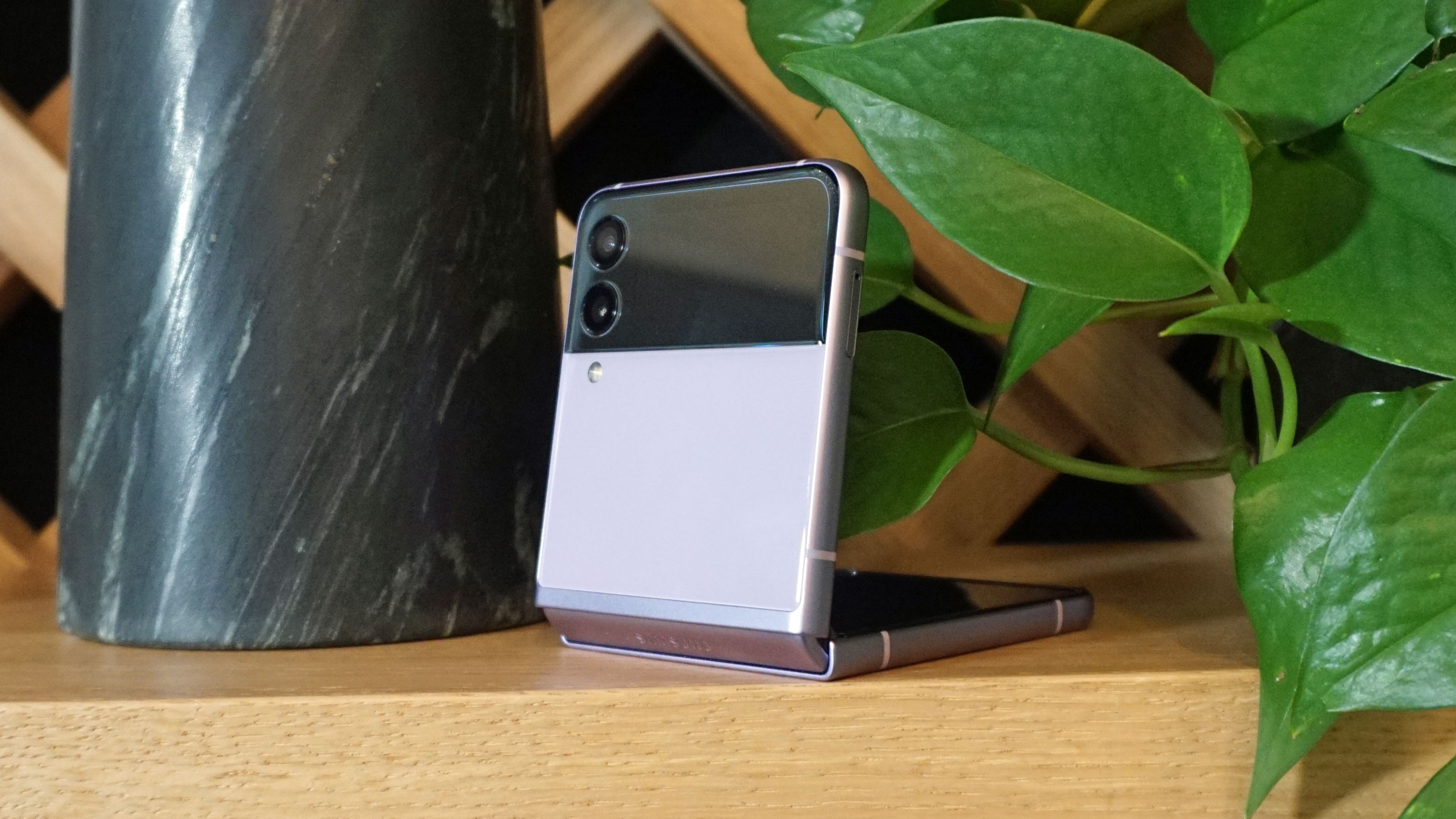
Samsung Galaxy Z Flip 3: design
- IPX8 rating for water - but not dust - resistance
- Compact design
The Samsung Galaxy Z Flip 3 doesn’t look much different from its predecessors, aside from an expansion of the outer display and a rearranging of the rear cameras around it. It’s still a clamshell foldable with two ‘halves’ rotating around a large, Samsung-branded hinge. Unfolded, it’s still a very tall and narrow phone, with a 6.7-inch display.
There are some (mostly aesthetic) improvements, however. While the phone doesn’t fold completely flush, there’s less of a gap between sides when it’s closed, and the protective plastic bumper ringing round the inner flex display is still there, but it’s thinner, looking more like a guardrail strip than the rounded pontoon layer lining the edge of the Z Flip’s screen.
The rear cover design has also been changed, from a single-color finish on the Z Flip to a two-toned effect on the Z Flip 3: the bottom two-thirds are a single hue, while the top third is all-black glass, and houses the outer display, with the twin rear cameras aligned vertically next to it. It’s a more handsome look this time around, although some of the color options are more appealing than others (our cream hue wasn’t terribly attractive).
The back is covered in Gorilla Glass Victus (which its maker, Corning Glass, claims is more durable than Gorilla Glass 6 with twice the scratch resistance), while the screen inside has a ‘glasstic’ flexible plastic display. For the first time in a foldable, Samsung has secured an IPX8 rating for water resistance, meaning the phone can be submerged in 1.5 meters of water for up to 30 minutes. It’s not rated for dust resistance, however (hence IPX8 instead of the more common IP68, with the ‘6’ denoting dust resistance).

Other than the enlarged outer display, the phone is set up much like its predecessor. On the right side is a lock button with a fingerprint sensor and a volume rocker above it, which are admittedly a bit high for comfort when the phone is unfolded – the former is just reachable with a thumb (to unlock the phone), but raising or lowering the volume is almost impossible to do one-handed.
This setup isn’t arbitrary – when folded up, the buttons sit in the middle of the side of the top half of the phone.
On the left side near the top is a SIM slot, although sadly there’s no microSD slot, so you can’t add to the built-in storage. The top only has a microphone, while on the bottom there’s a USB-C slot in the center, with a speaker on the right and mic on the left.
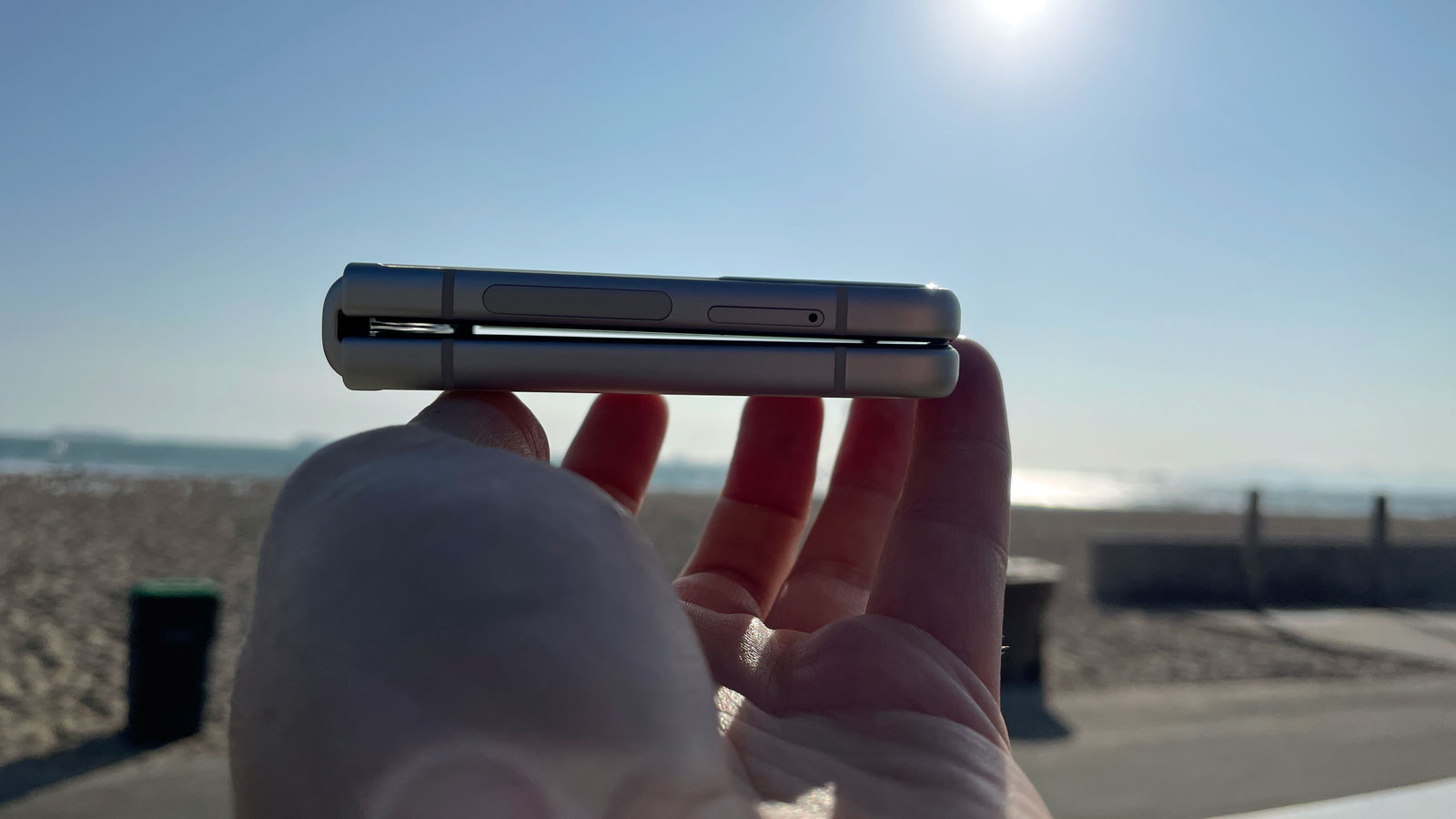
Samsung Galaxy Z Flip 3: what’s it like to fold?
The Samsung Galaxy Z Flip 3 is the best clamshell foldable on the market, although that’s not saying much given that the phone’s only competition is ageing Motorola Razr 2020. The phones take different approaches to the form factor: the Razr has more functionality on its outer screen, while the Z Flip 3 allows for unfolding the phone to any degree (until fully flat), with more functionality in semi-unfolded stages.
Unfolding the Z Flip 3 is a little tough to do one-handed (as was the case with previous Z Flip phones), but this resistance means you can unfold the device to whatever degree you want and feel confident it will stay locked in position, which is as functional as it is fun.
There are probably only a few use cases that would require part-folding the Z Flip 3, at least until more apps build in functionality that splits the screen (called Flex Mode), but having this option elevates some experiences above what normal phones are capable of. Video chatting is so much better when you can prop up your phone; likewise with taking selfies.

But mostly, the Z Flip 3’s foldability comes in handy when you’re carrying it around. While it won’t fit in some pockets – as iFixit found when folding closed older clamshells, the smaller footprint still results in a thicker phone – it’s a great feeling to slide it in a pocket or bag and not worry about the inner display getting scratched by keys or other bits and pieces.
The external display remains the foldable’s least impressive feature – it’s still too small to use for much beyond seeing notifications, previewing selfies, and controlling audio. The screen looks virtually the same in read-only mode (tap it once) and interactive mode (tap it twice), so it might seem like touch functionality is irregular, although it’s certainly more usable than its predecessor.
However, the Motorola Razr’s larger 2.6-inch outer screen still has more functionality, and can interact with more apps than on the Z Flip 3’s exterior display.
Samsung Galaxy Z Flip 3: display
- 6.7-inch 1080 x 2640 foldable screen
- 1.9-inch secondary display
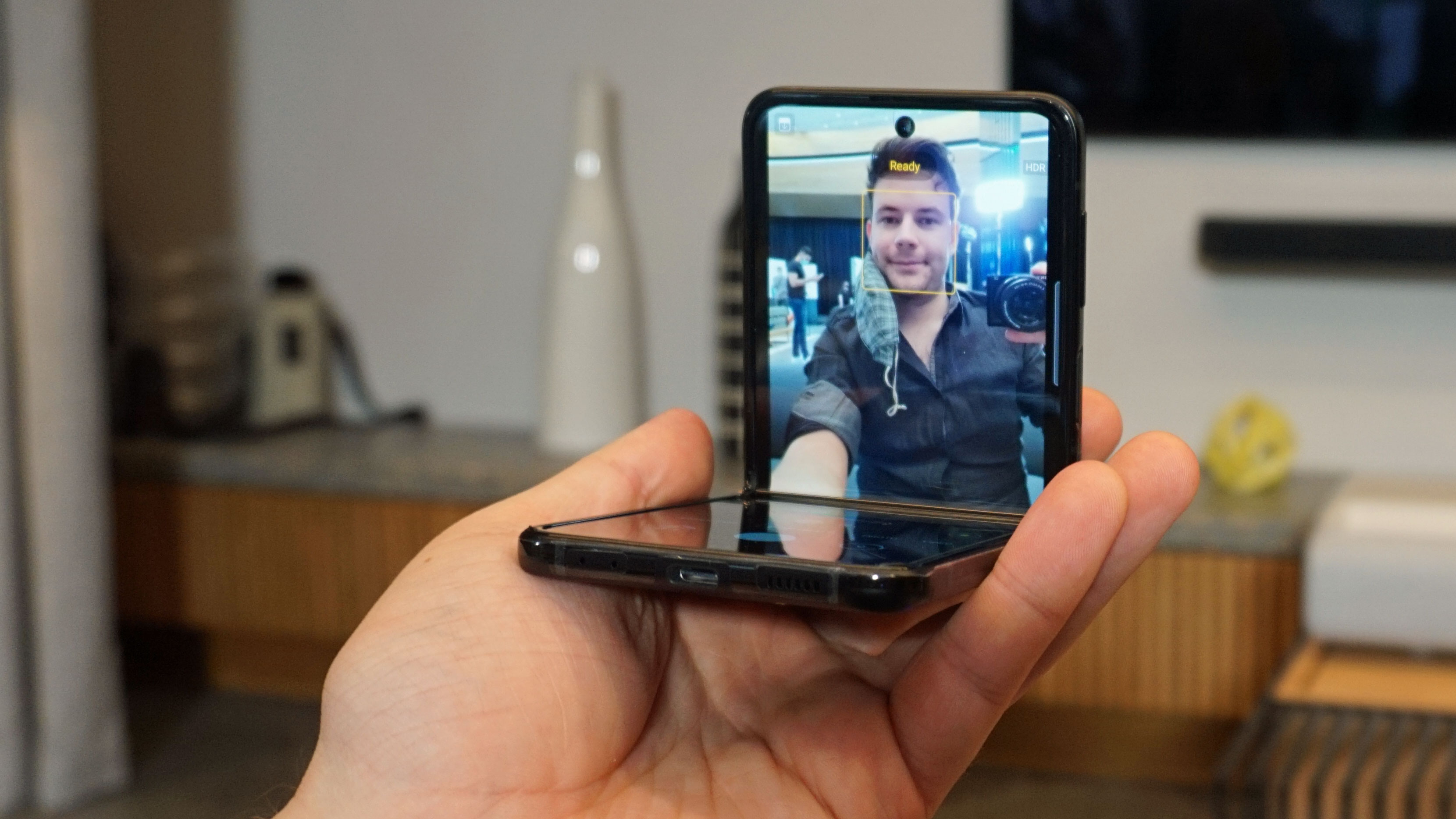
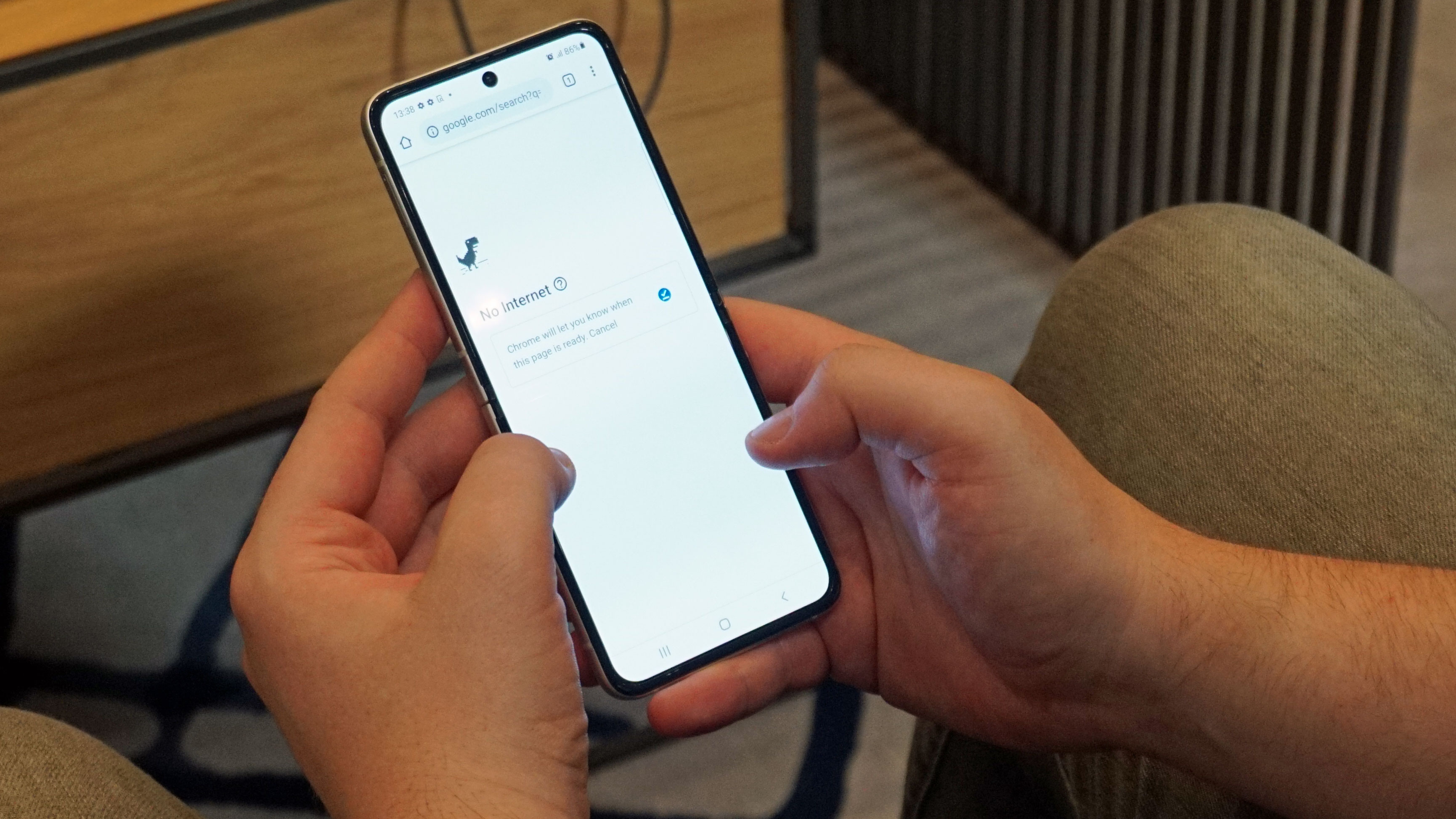
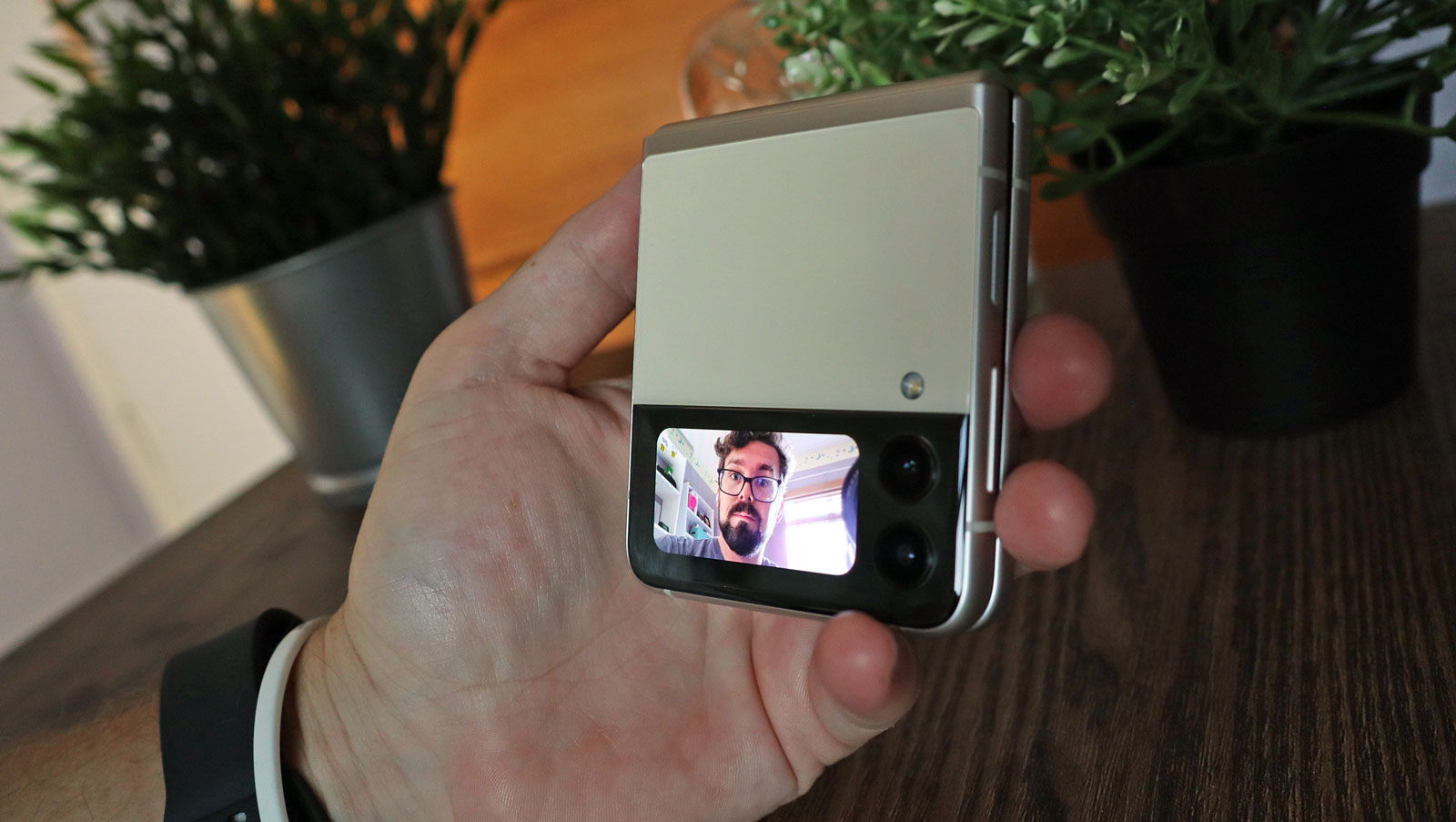
The Samsung Galaxy Z Flip 3’s displays have been improved, although not by too much, all things considered. That’s fine, but we’re still waiting for parity between glass and plastic displays – and no folding seam – before we’re blown away by clamshell foldables.
The seam is shallower than on previous clamshell foldable displays, and while you’ll still feel it while running your finger across the center of the 6.7-inch Full HD Plus (2640 x 1080) display, it’s not too annoying. The screen itself is bright enough for viewing outdoors, and has comparable visuals to other flagship Full HD displays, though it’s not quite as crisp as phones with OLED displays.
The Z Flip 3’s plastic inner display doesn’t seem to have an inferior picture compared to glass phones, but in side-to-side comparisons it may exhibit a slightly less sharp picture than screens on OLED phones. The screen has been slightly improved over the display on its predecessor, with a 120Hz refresh rate for smoother browsing and gaming.
As mentioned, the Z Flip 3’s 1.9-inch exterior display is nearly four times the size of the original Z Flip’s 1.1-inch outer screen. Instead of barely showing a single line of text, and perhaps the world’s smallest photo preview, the Z Flip 3’s larger screen makes it a lot easier to preview selfies, and there are mini-app widgets for simple audio controls, setting timers, and a few other things.
Samsung Galaxy Z Flip 3: cameras
- 12MP main and 12MP ultra-wide camera
- No telephoto lens
The Samsung Galaxy Z Flip 3 has enough cameras to handle casual photography, lacking any telephoto capability but managing everything else well. The phone benefits from Samsung’s impressive photo software, with images looking nicely detailed and colorful.
The pair of shooters on the back of the phone – a 12MP f/1.8 Dual Pixel main camera with optical image stabilization (OIS) and 12MP f/2.2 ultra-wide camera – don’t seem to have been changed from the pair on the Z Flip. That said, they capture photos that compare favorably to shots taken with other Samsung flagships, with good color balance in daylight.
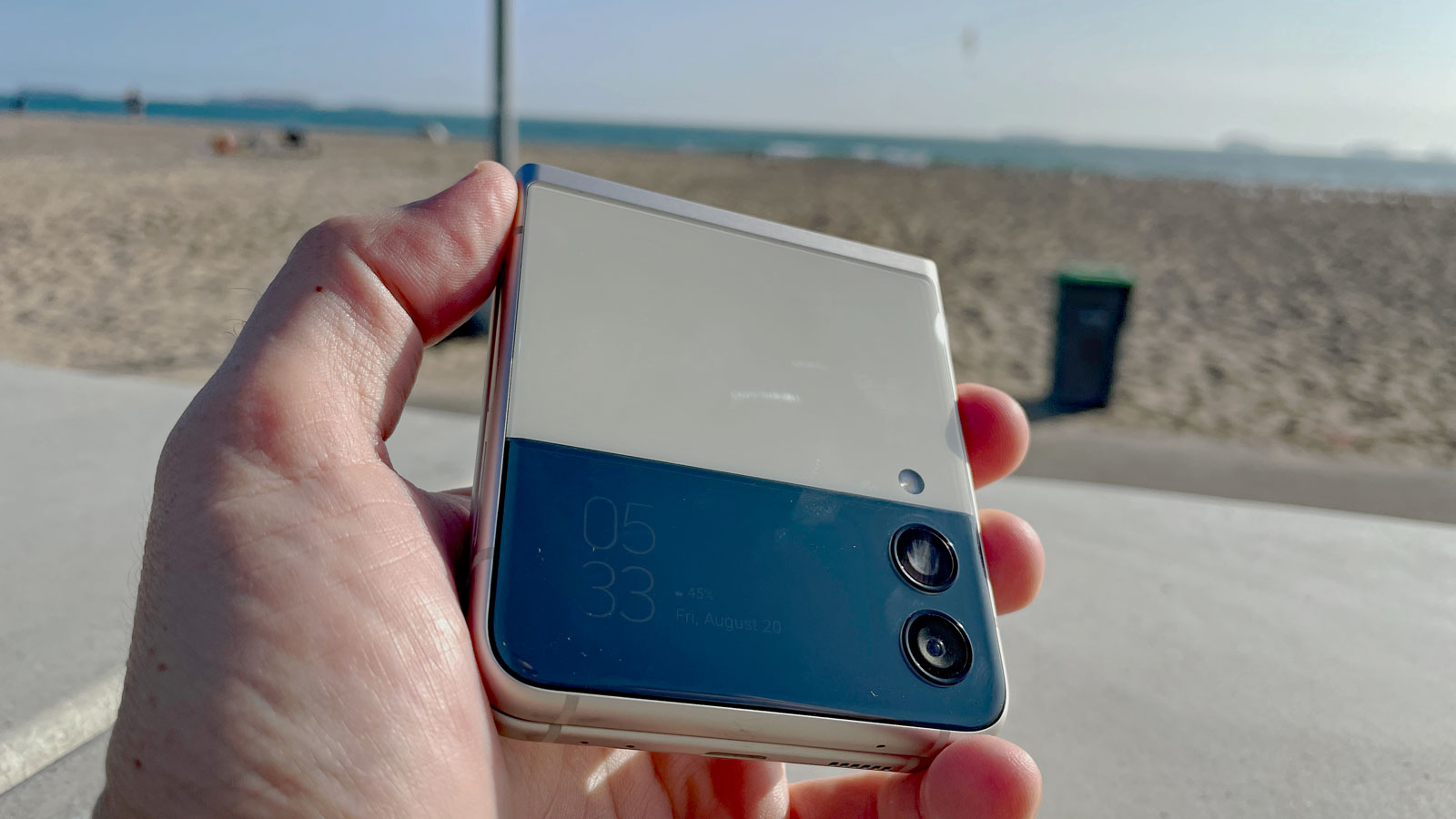
There’s a 10MP f/2.4 front-facing camera that takes decent selfies, although these have slightly less detail than shots from front-facing cameras in rival flagships like the iPhone 13. Still, this is the most selfie-friendly phone we’ve used in a while – being able to shoot with the phone unfolded halfway, with one side resting flat on a surface, is much easier than awkwardly bending an arm to fit yourself and others in frame, a practice that’s potentially trickier for folks without a wide range of motion.
The Z Flip 3 can also take selfies when folded closed, using the superior rear main and ultra-wide cameras, to take shots that are previewed on the outer display – just double-tap the lock button to open the camera mode. The touch interface is perfectly simple: swipe up to switch between the main and ultra-wide lenses, and swipe left and right to switch between photo and video.
It’s super-simple and a great party trick, and undeniably an easier way to take selfies. Just be aware that this mode inexplicably takes fully square photos (perplexing given the widescreen-formatted outer display) – and other photo dimensions aren’t possible.
Samsung Galaxy Z Flip 3: camera samples
Here are some samples taken with the Z Flip 3's rear cameras, as well as a selfie with the front-facing camera (well, front-facing when the inner screen is open):
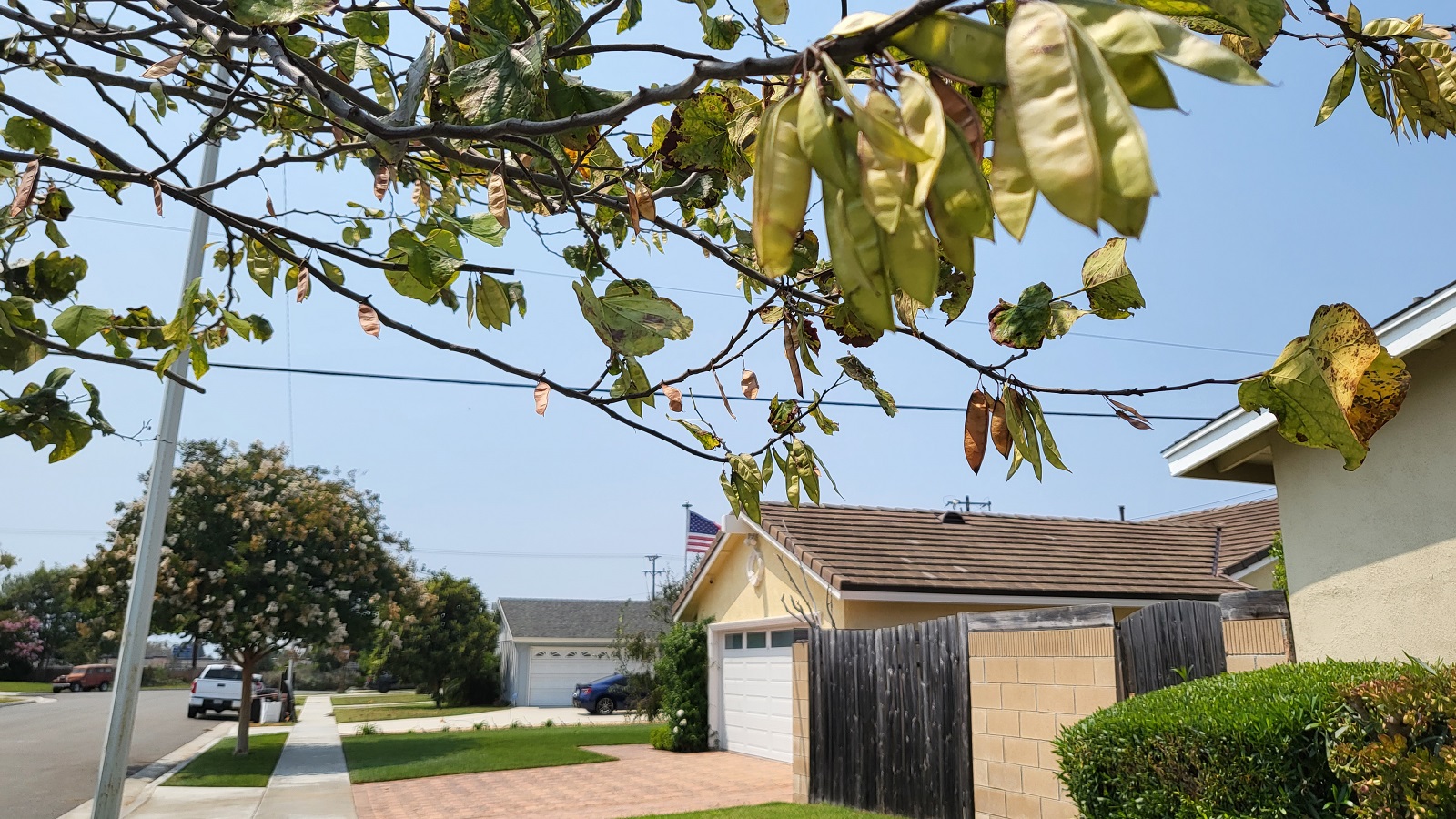


Some food photos, naturally:


And last, a zoom test, starting with ultra-wide, then main camera, and then in greater magnification using the crop zoom from 2x, 4x, and the maximum 10x:
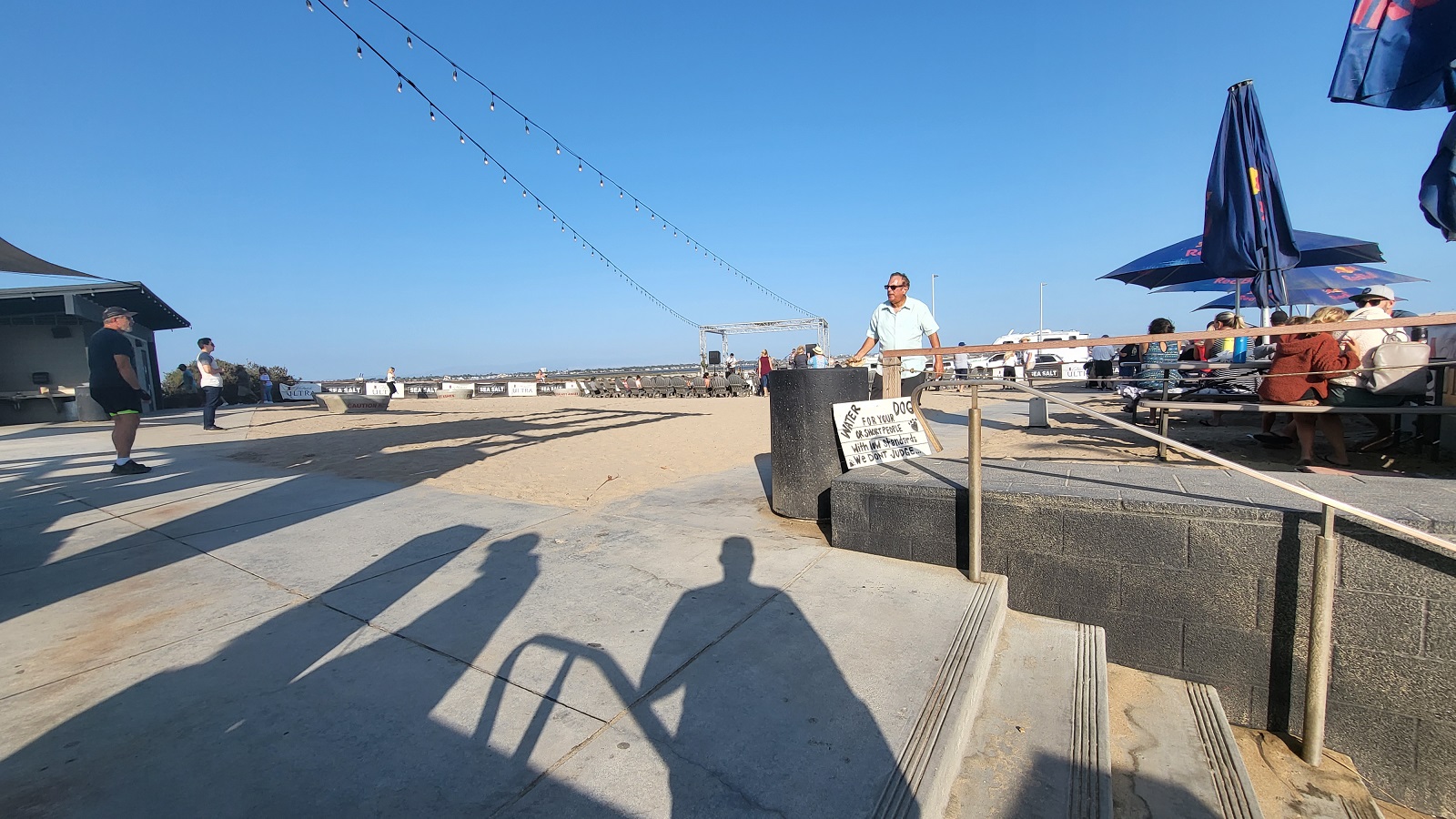

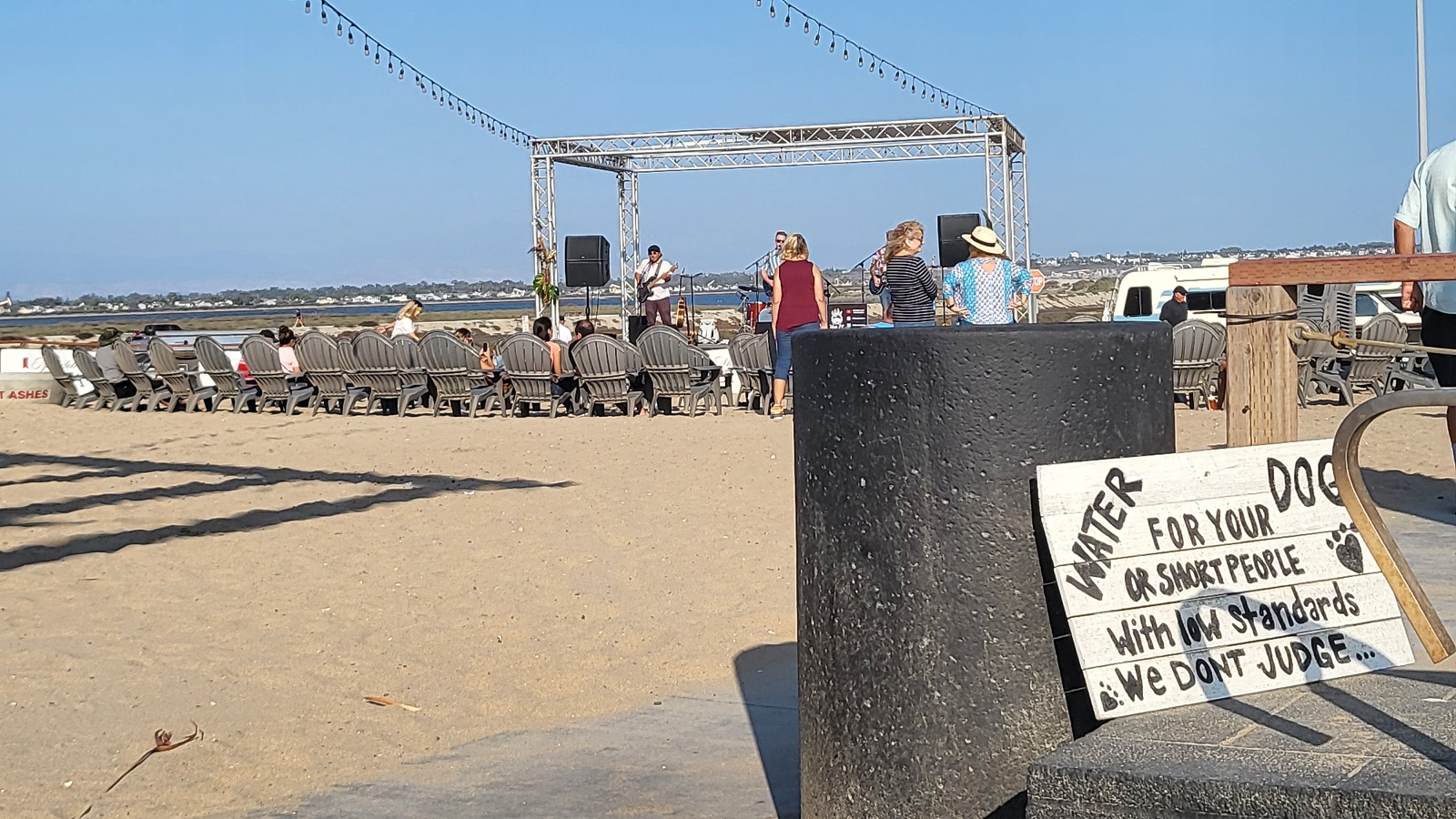
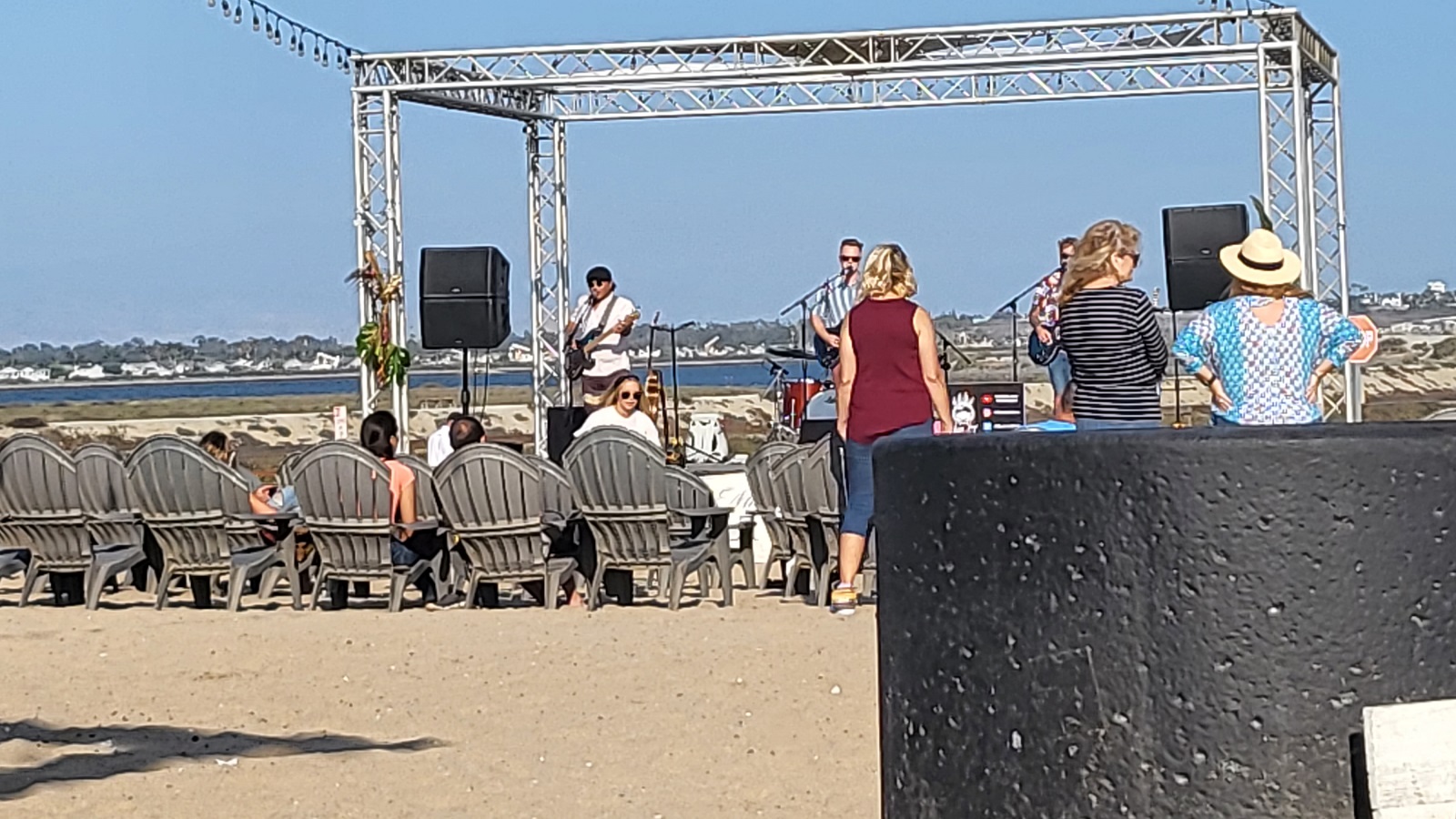

Samsung Galaxy Z Flip 3: specs, performance and software
- Snapdragon 888 chipset
- 8GB of RAM
The Samsung Galaxy Z Flip 3 has flagship 2021 specs, and performs as impressively as any phone outside the priciest top-tier handsets. It runs on the Snapdragon 888 chipset (which you’ll find in most leading Android handsets released in 2021), and has 8GB of RAM and either 128GB or 256GB of storage.
Unfortunately, the storage isn’t expandable via microSD, meaning you’re stuck with the onboard limit – but while it may seem like a step back to offer a 128GB version (the Flip and Flip 5G came in a single 256GB configuration), it ultimately allows the phone to be offered at a lower price point. It isn’t ideal, but there are alternatives, like cloud storage, if you need more space.
Overall performance is impressive: whether we were browsing the web, watching media or playing games, the phone didn't stutter or falter, and kept up with whatever we put it through. Its Geekbench 5 average score of 2801 was impressive enough at the time the phone was originally reviewed, though not quite on par with the year’s top-level phones like the Asus Rog 5 (3732) or iPhone 12 Pro (4007).
This average reflects a wide range of individual scores, from a high of 3252 to a low of 1953, and while we didn’t notice the phone’s performance vary in real-world tasks (we didn’t see any slowdown while watching video or playing games, for instance), most flagship phones have far less variance in their benchmarks.
As reviewed, the Z Flip 3 ran Android 11 out of the box, bringing the best perks from the Google then-latest operating system. Android 12 then made its way to the Flip in early 2022.
One of the big features in Android 12 is Material You, which redesigns your interface based on a user-chosen color palette – and the Z Flip 3 has its own version of that, enabling owners of a Samsung Galaxy Watch 4 or Watch 4 Classic to sync their watch face with their outer display, giving the latter matching colors, fonts, and even little images. It’s a small touch that folks might not use, but it’s cool to see more personalization on the outer display and pushes Samsung's notion of 'ecosystem'.
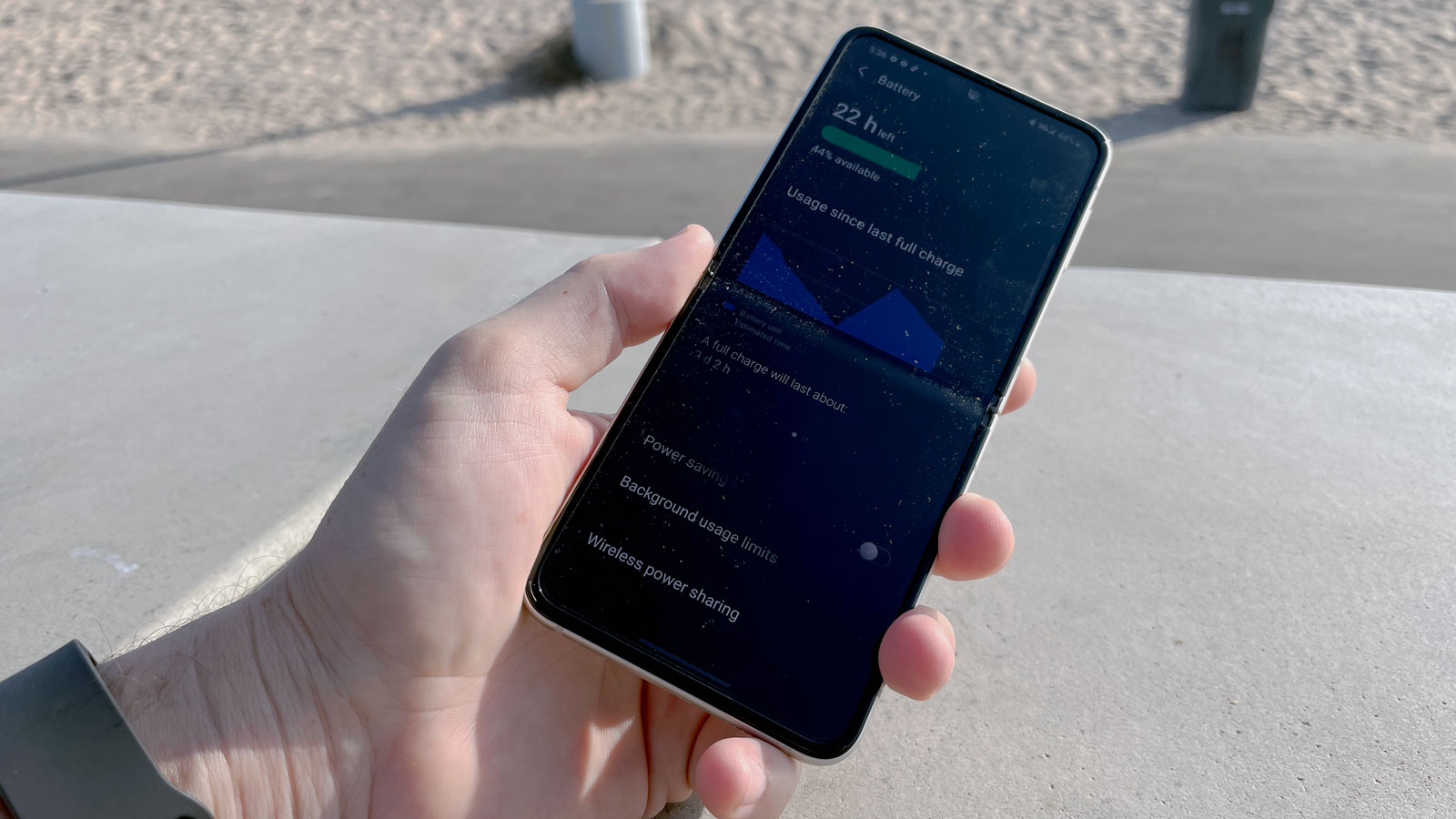
Samsung Galaxy Z Flip 3: battery life
- 3,300mAh battery
- Mediocre life
The Samsung Galaxy Z Flip 3’s biggest drawback is probably its 3,300mAh battery, which is far from the biggest battery among flagship phones, and steadily drains over the course of a day – don’t expect it to last into the second day. There’s also no charger in the box, as part of the company’s shift toward more sustainability and less waste (as well as saving on costs).
The battery drains a bit faster than most phones just by keeping the display live and the phone on; on one day, the phone held up until it hit around 10%, and then dropped sharply. But ordinary tasks shouldn’t drain this phone more than any other – for instance, watching a half-hour Netflix show sapped the battery by 3%, which is pretty typical.
We used the most powerful wall charger on hand, a 60W Asus brick, which recharged the battery to 46% in 30 minutes and 80% in an hour. Not bad, but not great compared to phones tuned to high-wattage recharging – the OnePlus 9 (a suitable rival around the time of review), for instance, recharged twice as fast (76% in 30 minutes in our test).
Should I buy the Samsung Galaxy Z Flip 3?
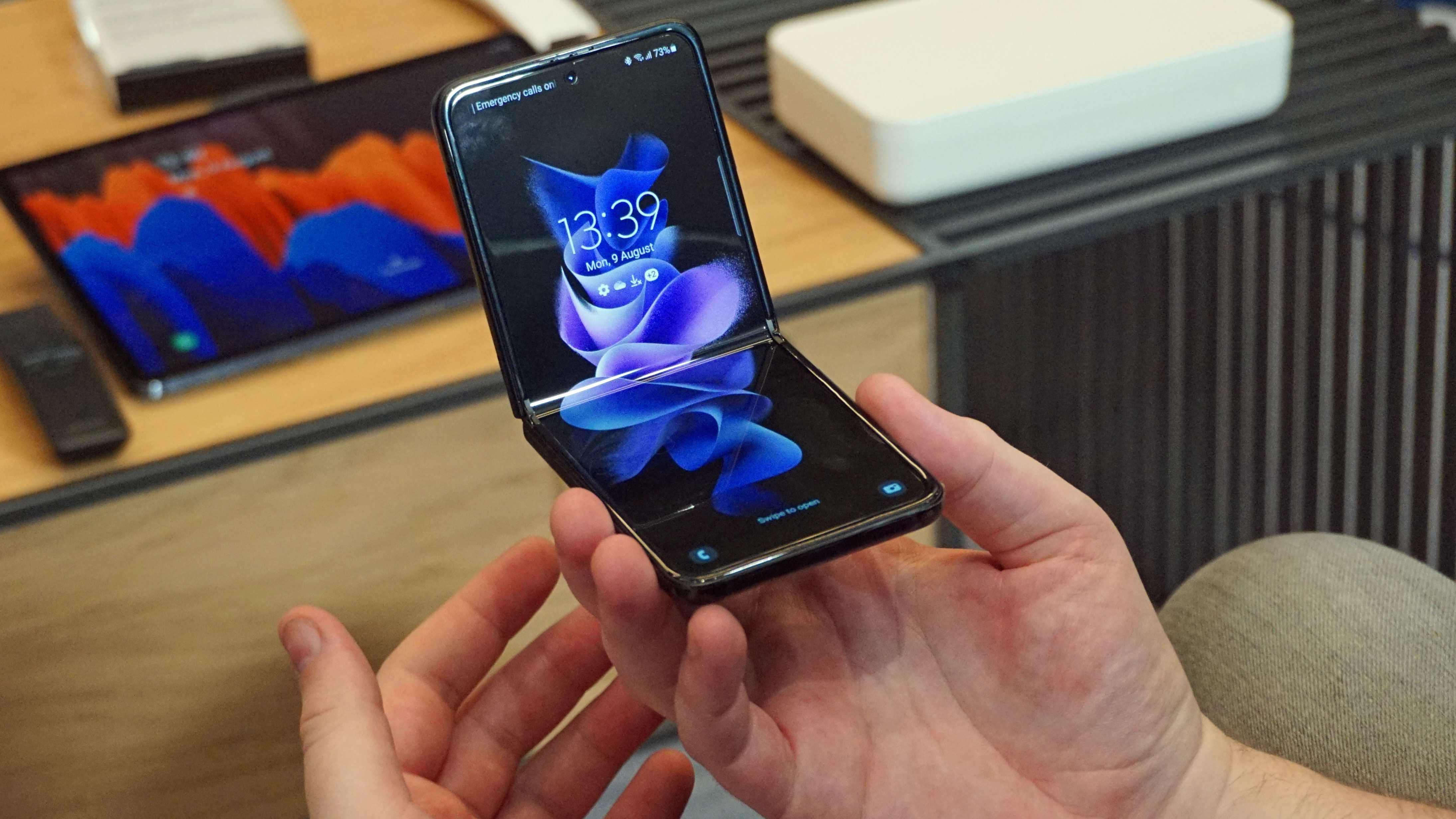
Buy it if…
You want the most affordable flagship foldable
Well, the Z Flip 3 isn’t exactly affordable, but it is the cheapest of the foldables currently on the market. If you want to try foldable phone tech out while spending as little as possible, get the Z Flip 3 (or wait for the Z Flip 4, which might cost even less)
You want a pocketable phone
The Z Flip 3’s biggest perk is certainly that it’s packing flagship capability in a foldable package, and at a better price than ever.
You want a selfie machine
Let’s be real: no phone makes taking selfies easy... except for the Z Flip 3. This is the phone to get for selfies and video calls if your favorite subject is you.
Don’t buy it if…
You want a flagship phone with a telephoto lens
The Z Flip 3 doesn’t have a telephoto lens – and take it from us, the maximum zoom is blurry. If you want a phone that can shoot distant subjects, opt for the Samsung Galaxy S22 Ultra or another handset with a telescope zoom lens.
You want more screen with your foldable
You may hear ‘foldable’ and be surprised that the Z Flip 3 only has as much inner screen area as a typical phone – if you want twice the display real estate of your usual handset (and S Pen stylus support), pick up the Samsung Galaxy Z Fold 3.
You want an even cheaper clamshell foldable
Like the ‘flip phone’ format but want it even cheaper? You can get an older Z Flip, Z Flip 5G, or Motorola Razr for less than the Z Flip 3 cost at launch.
Also consider
If our Samsung Galaxy Z Flip 3 review has you considering other options, here are three more phones to ponder.
Samsung Galaxy Z Flip 4
The Samsung Galaxy Z Flip 4 is a newer and better alternative to the Z Flip 3, but it's only a slight upgrade, with a larger battery and a faster chipset, but not much else changed. It costs a bit more as a result, but if you want Samsung's top clamshell foldable, this is it.
Read our Samsung Galaxy Z Flip 4 review for more
Asus Zenfone 9
If you're more just after a compact Android phone than a foldable then you could consider the Asus Zenfone 9. This has solid specs and a small 5.9-inch screen, but is a far more conventional smartphone than the Z Flip 3.
Read our full Asus Zenfone 9 review for more
Samsung Galaxy Z Fold 3
If you want a foldable with a bigger screen then the Samsung Galaxy Z Fold 3 - launched alongside the Z Flip 3 - is a strong option. This has a 7.6-inch display so it can double as a tablet, but it also costs a lot more, and is far from compact.
Check out our Samsung Galaxy Z Fold 3 review
First reviewed: August 2021

David is now a mobile reporter at Cnet. Formerly Mobile Editor, US for TechRadar, he covered phones, tablets, and wearables. He still thinks the iPhone 4 is the best-looking smartphone ever made. He's most interested in technology, gaming and culture – and where they overlap and change our lives. His current beat explores how our on-the-go existence is affected by new gadgets, carrier coverage expansions, and corporate strategy shifts.
